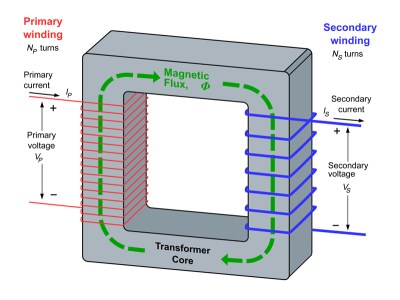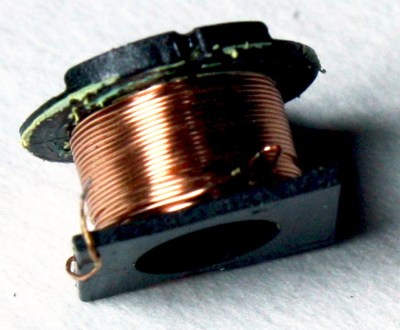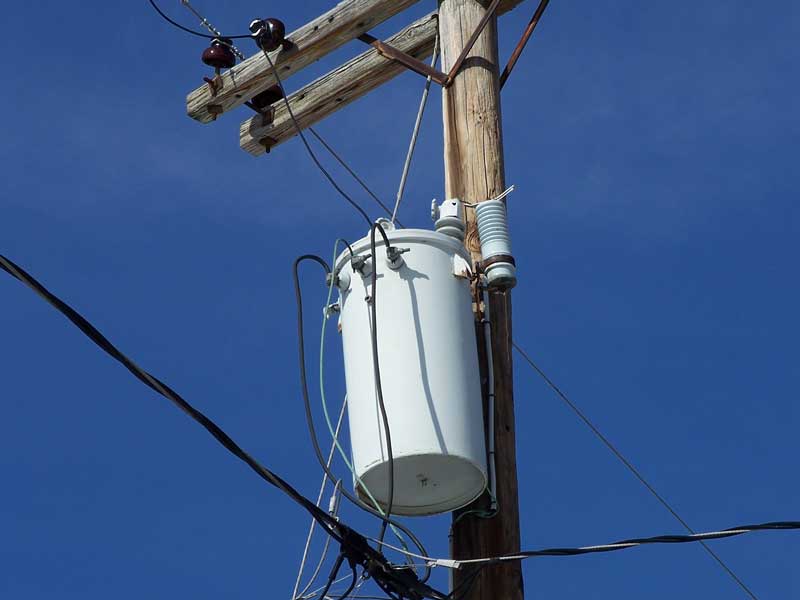Funny stuff, electricity. It’s all about the volts and the amps, and controlling these two factors. Most of the time, the electricity coming into your device is at a higher voltage than you need, so you have to convert it down to something more usable. The easiest way to do this is with a transformer.
The transformer in your power supply takes a high voltage from the mains and converts it down into a lower voltage to power your gadgets. You’ll find one in all power supplies, from the miniature USB version that powers your cell phone to the big ones hanging on a telephone pole that drive your home’s mains electricity. Although these transformers are different sizes, they share the same fundamental design.

The basic transformer is two coils of wire wrapped around a metal core. An alternating current is applied to one of these coils (called the primary), which creates a magnetic field in the metal core. This magnetic field, in turn, creates a current in the second coil, called the secondary. The relationship of these two currents is the important thing, and that is defined by the ratio of the length of each of the coils, usually defined as the number of turns that each coil makes. If the two coils have the same number of turns, the current going into the primary and out of the secondary coil will be almost identical. If the secondary coil has twice as many turns, the voltage will be almost doubled. If the secondary coil has half as many turns, the voltage will be almost halved. This helps to explain the naming used by transformers: step up and step down. The step up type creates a higher voltage (such as the one used in this Jacobs ladder), while the step down type reduces the voltage.
For a transformer to function, alternating current (AC) must be used. AC produces a changing magnetic field (called the flux) which induces a current in the secondary coil. If there is no changing magnetic field, there will be no induced current. If you need a DC output, the sequence in a power supply will start with a transformer to step down the AC from the wall socket to a lower level, then this lower voltage AC will be converted into the DC that is output by the power supply.

There are lots of factors that affect how transformers work. These include what the core is made of: the metal affects how the magnetic field flows. Some of the energy in the magnetic field also inevitably gets lost before it creates the current in the secondary coil, called an eddy current loss.
All of these affect how the transformer performs, so most transformers are custom designed for the specific purpose in mind. Transformer design is a complicated art that requires a lot of factors to be taken into consideration. A good start is a design guide like this one from Wurth, who make transformer components and kits.
There are also several different types of transformers, including flyback types used in high-voltage designs, like Cathode Ray Tubes (CRT), toroidal types that contain the magnetic field, autotransformers that can handle different input voltages while still producing a fixed output voltage, aircore transformers, which have no metal core and are smaller, and pizeo transformers, which use a pizeoelectric element to detect physical force.
You don’t need a kit to experiment with transformers, though. A transformer can be as simple as a couple of bits of wire wrapped around a few pieces of steel, or two pieces of wire wrapped around a metal ring, so it is easy to experiment on your own.

















Transformers are found in all power supplies except for the ones that don’t use transformers.
http://s2.quickmeme.com/img/1b/1b338818e097f664b83a31fd2d507cdbe6d96a50090dbb7a111a116c646b6aa0.jpg
Thanks, Cap!
The tautology club approves of your comment (except for those of us who don’t)
Maybe add something about isolation and safety, you know, the real reason you use a transformer. UL-506, UL-5085-1,2,3, maybe something about recognized insulation systems.
Maybe a few pictures of magnet wire, Litz wire and copper tape transformers, maybe when you might want to use one over the other?
Maybe show a picture of a planar transformer that uses PCB traces as windings?
Maybe talk specifically about a flyback transformer since it’s not really a transformer but coupled inductors, energy storage and all that.
It sounds like you know a lot about transformers. In all seriousness, maybe consider writing a more in-depth article to follow this introductory article?
It sounds like you have relatively deep knowledge of transformers. In all seriousness, have you considered maybe writing and submitting a detailed article that could supplement this introductory piece?
Can just write it here like many others do. As for Safety – tip number one – don’t lick the insulators of high voltage mains step down transformers.
Don’t tell me what to do, you’re not my real dad!
Millions of TV’s with line power voltage doublers and hot chassis. And don’t forget the all American Five with line power and no transformer ready to kill anyone willing to hook up a better speaker.
“and no transformer ready to kill anyone willing to hook up a better speaker.”
Let’s eat Grandma!
Let’s eat, Grandma!
Commas save lives
^and no transformer, ready to kill anyone willing to hook up a better speaker.^
Cute. Now try Capital Letters – the difference between helping your Uncle Jack off his horse, and helping your uncle…
And semicolons drive people crazy when I use them; wrong.
Transformers, more than meets the eyes.
Hehe, whenever I see the word ‘transformer’ I can’t help but think of this line:
“Transformers! Less then meets the eye. Transformers! Touch one and you’ll fry!”
:P
I’m am wondering if the errors in the article text were deliberately added to get responses.
Ha! I must say I almost fell for this clever ruse. I call it a ruse, for the alternative is too terrible to contemplate.
Isn’t the title of this Hack-a-Day article a bit misleading? I was expecting something about a movie series with Autobots and Decepticons http://www.imdb.com/title/tt0418279/
If you had been right, which side would that ‘residential power distribution transformer mounted on a utility pole’ be on?
Honestly, I can’t stand the Transformers movies. I dislike Shia LaBeouf that much. That and either the cars should sink into the ground or the Auto/Deceptaroboticon’s should float away with the wind.
Bad physics + Bad acting = Crap Sandwich
According to the article it is called a “telephone pole”. I had stuff to think about all afternoon.
I did a Google image search. Said photo is from Wikipedia.
https://commons.m.wikimedia.org/wiki/File:Power_Transformer.jpg
But normally I would call it a telephone pole. :)
I feel we should also mention Michael Faraday, who invented the transformer, as well as the first electric motor, the Faraday cage and Faraday’s law of electrolysis, and must have had something to do with capacitors as well since the farad is named after him. Also he demonstrated that light is an electromagnetic phenomenon by showing that a magnetic field could rotate the angle of polarisation of light. The “List of things named after Michael Faraday” in the Wikipedia runs to fifteen items, including Faraday’s paradox, which was one of the inspirations for relativity. I believe he should get far more credit as an architect of the modern world than he does.
Be very careful when you play with transformers though, it might kill you if you connect the wrong side. It will work as a step up transformer, and that means “Very High Voltage”!
It will be very nice if somebody would write about it much more, e.g. diference between transformers, characteristics, and comparison, eg. Optimus Prime vs Bumblebee vs Megatron :-D
Ok the first paraph on this article is pretty cringe worthy. I am only a MechEng but I feel like I know better. Since this is a tech site I don’t feel tooooo guilty for being pedantic
“The basic transformer is two coils of wire wrapped around a metal core”
No need for a core if we want the basicist xfrmr, two coils sharing an axis will work (poorly). Although I will concede a core is much much much more common, so if basic= common, you win here, but its all down hill after this.
“An alternating current is applied to one of these coils (called the primary), which creates a magnetic field in the metal core. This magnetic field, in turn, creates a current in the second coil, called the secondary. The relationship of these two currents is the important thing”
So far so good
“, and that is defined by the ratio of the length of each of the coils, usually defined as the number of turns that each coil makes.”
oof, nope. ratio of the turns is the key thing, ratio of the coupled turns is the scientificly critical thing but that is just being too fussy. Length is mostly irrelevant tho.
“If the two coils have the same number of turns, the current going into the primary and out of the secondary coil will be almost identical. If the secondary coil has twice as many turns, the voltage will be almost doubled. If the secondary coil has half as many turns, the voltage will be almost halved.”
If trying to explain to newbs, don’t jump between topics. stick to what you called the important thing, the current. Twice the turns in the secondary? half the current in the secondary. half the turns? twice the current! Voltage goes the opposite way, so twice the current, half the voltage, power is constant, which is the REAL key thing imho, but current works too. Voltage gets tricky in wierd/special cases so I always stick with current or power. Also easy way to remember si that amps*turns is the real constant.
This helps to explain the naming used by transformers: step up and step down. The step up type creates a higher voltage (such as the one used in this Jacobs ladder), while the step down type reduces the voltage. ”
ok I feel rude but I had to say something…
Air core isn’t all that uncommon in RF transformers.
The effect of turns ratio is express as a ratio of voltages and not current as current can be misleading because people tend then to calculate power and power is the *fixed* aspect of a specific transformer core.